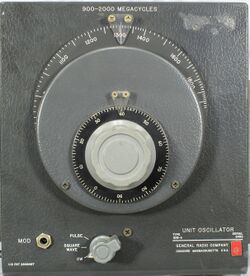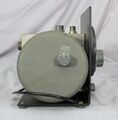1218-A
The General Radio 1218-A Unit Oscillator was introduced in Catalog P (1959) and remained available through Catalog R (1963).
The 1218-A is a general-purpose frequency source covering 900 to 2000 MHz. It finds use as a generator for bridges, admittance meters, and impedance meters.
Direct amplitude modulation at audio frequencies is provided by a front panel phone jack. With a 1000-P6 Crystal Diode Modulator accessory, modulation from 0 to 20 MHz is possible that is essentially free of FM. The output of the Type 1218-A can be monitored by a voltmeter and can be kept constant by the Type 1263-B Amplitude-Regulating Power Supply. In combination with an 874-GA Attenuator, an 874-VR Voltmeter Rectifier, and an 874-VI Voltmeter Indicator it provides an accurately known output voltage for receiver testing. A Sylvania 5675 UHF Medium-mu Pencil Triode is used as the oscillator tube, see below for the data sheet.
The recommended sweep drives are, Types 908-P1 and 908-P2, 908-R12, 908-R96, and the 1750-A. Being part of the Unit Oscillator family, it requires a separate power supply or a modulating power supply. The Type 1263-B is one of the recommended power supplies.
Specifications
- Frequency Range: 900 to 2000 MHz.
- Frequency Calibration Accuracy: ±1
- Warm-up Frequency Drift: 0.1%
- Output Power: 200 mW into a 50 Ω load













